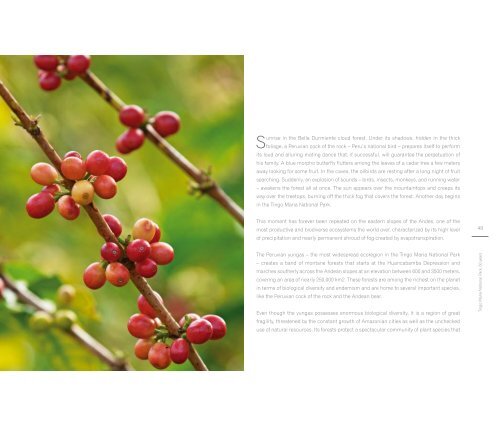XWexe8
XWexe8
XWexe8
You also want an ePaper? Increase the reach of your titles
YUMPU automatically turns print PDFs into web optimized ePapers that Google loves.
Sunrise in the Bella Durmiente cloud forest. Under its shadows, hidden in the thick<br />
foliage, a Peruvian cock of the rock – Peru’s national bird – prepares itself to perform<br />
its loud and alluring mating dance that, if successful, will guarantee the perpetuation of<br />
his family. A blue morpho butterfly flutters among the leaves of a cedar tree a few meters<br />
away looking for some fruit. In the caves, the oilbirds are resting after a long night of fruit<br />
searching. Suddenly, an explosion of sounds – birds, insects, monkeys, and running water<br />
– awakens the forest all at once. The sun appears over the mountaintops and creeps its<br />
way over the treetops, burning off the thick fog that covers the forest. Another day begins<br />
in the Tingo Maria National Park.<br />
This moment has forever been repeated on the eastern slopes of the Andes, one of the<br />
most productive and biodiverse ecosystems the world over, characterized by its high level<br />
of precipitation and nearly permanent shroud of fog created by evapotranspiration.<br />
49<br />
The Peruvian yungas – the most widespread ecoregion in the Tingo Maria National Park<br />
– creates a band of montane forests that starts at the Huancabamba Depression and<br />
marches southerly across the Andean slopes at an elevation between 600 and 3500 meters,<br />
covering an area of nearly 250,000 km2. These forests are among the richest on the planet<br />
in terms of biological diversity and endemism and are home to several important species,<br />
like the Peruvian cock of the rock and the Andean bear.<br />
Even though the yungas possesses enormous biological diversity, it is a region of great<br />
fragility, threatened by the constant growth of Amazonian cities as well as the unchecked<br />
use of natural resources. Its forests protect a spectacular community of plant species that<br />
Tingo María National Park, 50 years


